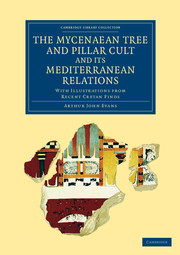
-
Select format
-
- Publisher:
- Cambridge University Press
- Publication date:
- October 2014
- June 2013
- ISBN:
- 9781139794862
- 9781108060912
- Dimensions:
- Weight & Pages:
- Dimensions:
- (297 x 210 mm)
- Weight & Pages:
- 0.32kg, 126 Pages
You may already have access via personal or institutional login
Book description
Sir Arthur John Evans (1851–1941), the pioneer of ancient Cretan archaeology, most famously excavated the ruins of Knossos and uncovered the remains of its Bronze Age Minoan civilisation (as detailed in The Palace of Minos at Knossos, also reissued in this series). In this highly illustrated work, first published in 1901, Evans surveys the recent archaeological evidence from his dig at Knossos as well as from other locations around the Mediterranean. He describes a variety of religious objects and symbols, especially those concerned with sacred stones, pillars and trees, which Evans argues are characteristic of religious worship in the Mycenaean period. He considers in particular the importance of the Cretan double-axe symbol, the labrys, its close link with depictions of bulls and its association with the labyrinth of Knossos. Elsewhere he examines the symbolism of the Lion Gate at Mycenae and finds parallels with similar artefacts found in Crete and Egypt.
Contents
Metrics
Full text views
Full text views help Loading metrics...
Loading metrics...
* Views captured on Cambridge Core between #date#. This data will be updated every 24 hours.
Usage data cannot currently be displayed.
Accessibility standard: Unknown
Why this information is here
This section outlines the accessibility features of this content - including support for screen readers, full keyboard navigation and high-contrast display options. This may not be relevant for you.
Accessibility Information
Accessibility compliance for the PDF of this book is currently unknown and may be updated in the future.


